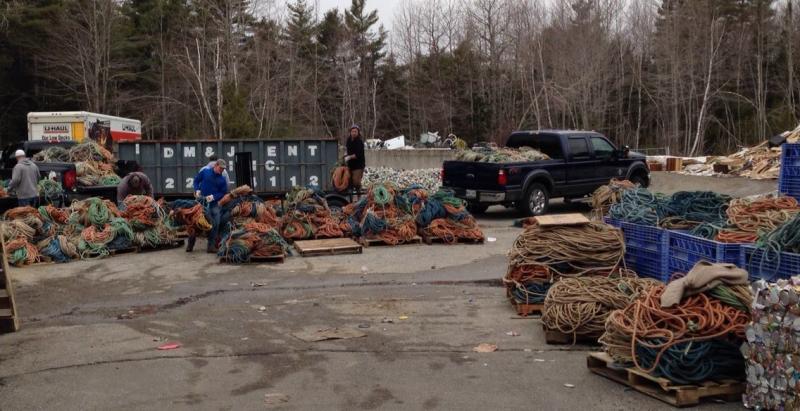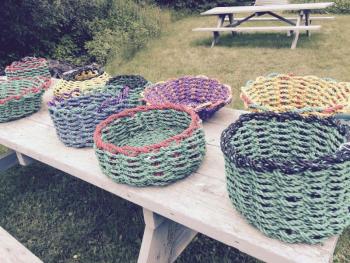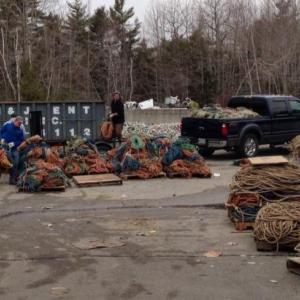Eva Murray: Pot warp, and its huge waste stream
Pot warp. That what it’s called. Fishermen who only call their lobster traps “lobster traps” and never say “lobster pots” still say “pot” warp. It’s rope for lobster pots…uh, traps. It’s just a name, and the name’s not so important.
It’s also sort of an elephant in the living room, and we’re all trying not to notice.
Lobstermen use huge quantities of the stuff, particularly if they fish offshore or in the winter, and it needs to be changed with some regularity as it degrades. A typical fisherman will own many miles of the stuff. The question: just what the Sam Hill are people supposed to do with all this rope?
I ask this question now for three specific reasons. First, the Maine Resource Recovery Association’s annual recycling and solid waste conference and trade show is being held Monday and Tuesday, April 24-25 at the Samoset (the same location where a few weeks ago we gathered for Fisherman’s Forum). Recycling and solid waste professionals of all sorts, “dump men” and PhD chemists, environmental activists and garbage truck drivers, selectmen and scrap metal dealers and regulators and volunteers and people who run the transfer stations all over the state meet and share their knowledge and experience. It’s a very nice convention, generally held in a very nice hotel, but I call it “dump school.” I always study hard and learn a lot. Maybe we’ll talk about rope over lunch. We’re nerdy that way.
But there are other reasons for the timing of my gentle query. Where I live most of the fishermen take a few months off in the winter, haul the boat, get some maintenance done, perhaps take a vacation. Legally they can haul year-round at Matinicus, but many choose not to. This time of year they return from winter jobs ashore or Florida vacations or “RV Nation” and are eager to get back to work. There is a great deal of shop work to be done, repairing and updating lobster gear. Worn-out rope gets replaced—a lot of it.
Third, if a native-born, year-round-resident, commercial-fishing neighbor gets told by colleagues to “mind their own rackin’ frackin’ business” when they criticize other fishermen for burning rope on the shoreline, damn sure nobody else would get very far expressing their opinions on such a disposal method. Traditional practice or not, the fact remains that burning polypropylene rope in an open fire results in a lot of oily black smoke; environmental issues aside and fire safety concerns notwithstanding, it’s not the most neighborly behavior. Of course in some places, like out here, it’s somewhat routine. That’s how “it’s always been done.”
Except that years ago rope used to me made of other things, natural fibers which may have had their problems but did not create the same oily black smoke (yes, I know, tarred line--used for some purposes in commercial fishing-- obviously did. Life was not pristine in the old days. Still, you could somewhat more safely burn the old-style rope, and that’s where our habits come from.)
We might do well to think of pot warp as in a category with things like agricultural plastic or the carpeting in huge office buildings. It’s in the background, rarely noticed, and those in the industry cannot do without it-- and it’s made of petroleum-based plastic, and there’s a hell of a lot of it. When it’s time to change it out and throw it away, things get difficult.
As the solid waste coordinator I have been asked by several of the island fishermen to find an alternative way to dispose of our pot warp besides burning it on the rocks or landfilling it. Forget the stereotypes; some of the guys really do hope for a cleaner way. There are a few who resist any changes from how their grandfather operated, but those who claim tradition ignore the fact that Grampie didn’t have all this plastic. Anyway, as some stand upwind of their burn pile and others pitch it into a big pile in the backyard and learn not to see it, I haul what I can to the mainland, to a facility with which we have an agreement, and we absolutely do not object to paying the rate, and are grateful. But that still puts the plastic in the ground. Our Matinicus Island recycling system routes some of the better used rope to a local mat-maker, and I’m looking for a way to get all the rope we collect, aside from the small amount which is re-used here, to somebody who can use it.
But it isn’t all that useful.
Yes, once in a while an artist will take a good-sized heap of used fisherman’s rope and make something out of it. Massive as those installations seem when on the news, an art project now and then doesn’t begin to touch the quantities the whole coast of Maine is dealing with. Likewise, individuals and local companies make doormats and a few other items out of the stuff, which is a good idea, but again, can scarcely tackle the quantity and does not deal with the truly worn-out rope that isn’t worth repurposing. Also, most folks who can use it want a specific type and diameter of rope, not a random mix.
Laura Ludwig, who worked for the Gulf of Maine Lobster Foundation at the time of the rules change regarding lobster trap float rope a few years ago, explained to me how, “We (GOMLF) did float rope buybacks from 2007-2010 and collected over 2 million pounds of groundline from over 1,154 Maine lobstermen. This was a federally-funded buyback through which $2,868,594 worth of vouchers were distributed toward the purchase of replacement sink rope.” (A change in lobster gear regulations, intended for the safety of whales, resulted in a massive glut of used rope at that time). “Over 1 million pounds of the float rope was sent to Conigliaro Industries in Framingham MA where it was chopped up and used as a lightweight aggregate in concrete products.”
Unfortunately, the rope buy-back program was a short-lived, one-off project connected with the rules change. Now, it’s back to “every man for himself” to figure out what to do with old rope.
Ludwig continued, “After the sinking groundline regulation went into effect in Maine (2009), and after the rope buybacks were over, used float rope actually became scarce. I think you will have no problem getting rid of any poly(propylene) you have -- because as you know, poly is preferable to sink rope in making doormats. However, getting rid of used (polyester/dacron) sink rope is a lot tougher. I've had some luck working with a sculptor in NYC (http://orlygenger.com/) who has bought over 300,000 pounds of used sinking groundline from lobstermen in ME, MA and RI in her rope sculptures, but she has so far only wanted 1/2" line, and she works by commission only, so it's not a steady demand.”
Art and door mats are a start, but not a permanent system.
“I have yet to locate anyone who can use the old 3/8 or 7/16 sink rope in any meaningful way, but I keep my ears open,” says Ludwig. “It's a huge waste stream and very difficult to manage.”
We cannot avoid the topic of plastics in the marine environment as part of this conversation. Overboard dumping gets it out of sight and out of mind but certainly not out of the system. Plastic items simple break into smaller and smaller bits of plastic while the total mass remains nearly the same. Marine animals eat the specks of plastic thinking it other marine life, end up with a gut filled with trash, and basically starve to death. This happens all the time.
Spare me any lectures about running for the cops and the town office and the fire warden and the environmental agencies when some fisherman’s got a rope fire going; just spare me. The point is, the whole lobster fishing industry (not just any one municipal solid waste system) needs a way to get this stuff out of the way, without causing further troubles to the neighborhood air quality, to the trash-handling machinery, to the marine ecosystem, or to the people who deal with the stuff every day be they retailers, fishermen, or we who load an occasional island garbage truck and put it on the ferry.
I’d be interested in hearing what lobstermen do with their pot warp when it’s time to change it out and throw it away. In fact, I’d be interested to hear whether they even feel like this is a conversation we can have in public. Good chance the only feedback I’ll get is a hint to leave this subject alone.
I’d be interested to hear what the area solid waste facilities see, and what they recommend, and what they don’t want done. I know loose rope is a problem for machinery, getting tangled in heavy equipment such as bulldozers and loaders that work in landfills, and in conveyors in trash-to-energy plants and solid waste sorting facilities.
I’d be interested to hear what the offshore fishermen, and the around-town high-liners, and anybody who generates large quantities of the stuff every year thinks we ought to be doing with it—regardless of what they currently do with it.
I’d be interested in what the marine suppliers have to say. Do they get inquiries about whether there are take-back programs or drop-off places? Does anybody know how much pot warp is sold each year in Maine? It’s a lot.
We can landfill plastic products, or we can burn them, or we can-deep six them, but they do not go away. The question still remains: if those are all damaging practices, what are we supposed to do?
Don’t say, “Have your municipal solid waste hauler come take it away.”
I am the municipal solid waste hauler for my community. I’ll take it away, sure, but only to a larger solid waste facility, which doesn’t have any particularly inspired way to get rid of it either, no fault of theirs. It doesn’t often get truly recycled.
At “dump school” years ago, in discussions of “product stewardship” and “extended producer responsibility,” I kept asking about paint. Evidently I was not the only one who kept bringing up paint, because eventually, Maine got a take-back system in place for paint. Now, a consumer can take their unused paint back to the paint store, and it doesn’t have to be the store where they bought it, and they didn’t have to pay the deposit on that specific can—and the paint dealer will take it.
There is a system for proper recycling and disposal of paint, just like there is for car batteries, and there is (supposed to be) for electronics, and mercury devices like fluorescent tubes, and returnable beverage containers in states like Maine which have a “bottle bill.” It’s never a perfect system, but a system of some kind is a start.
All too often when the do-gooders and the politicians and the very earnest and well-meaning who know nothing of a given industry get some authority, they think it’s simple to just say “Thou shalt not,” without a plan. This isn’t a matter for somebody in a suit to handle. We don’t need a pat “thou shalt not” without a mechanism in place for a workable “here’s what you can do…” We need permanent places to take used rope for disposal, ideally where at least some of the massive quantity can be re-processed, re-purposed, or recycled. We should strive for extended producer responsibility or some sort of full-time take-back. This is a coastal-dwelling, commercial-fishing, rope-buying, local-landfilling, fire hazard, right in our dooryard New England issue.
If I even suggest we start to begin to consider a program that’ll add a few cents to the price, in order to help deal with end-of-useful-life of the stuff, all hell will break loose. “You cannot seriously talk about raising costs!” No, maybe not. A coil of pot warp can run a hundred bucks. With all types of trash, though, and with everything having to do with solid waste, or disposal, or recycling, it’s the old line: pay now or pay later.
If you have any feedback for Eva, please e-mail her at eva@midcoast.com. She’ll be at the MRRA conference Monday and Tuesday April 24th and 25th in Rockport.
Event Date
Address
United States




































